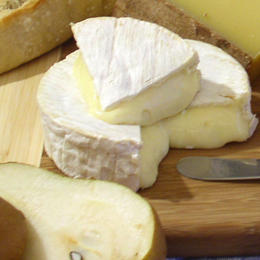Selecting A CheeseNow that you have some background about these cheeses, let’s discuss selection. Americans are accustomed to enjoying an unripe brie paste—one that can be cut into neat wedges that keep their shape. That’s what’s available at most supermarkets, and we just don’t know better. Many Americans have the wrong idea about the texture of the paste when cheeses are ripe, especially where double-crème and triple-crème cheeses are concerned. Real Brie should “bulge” or flow minimally, but not run. A truly runny interior (the cheese runs out of the rind and onto the plate) often indicates that the cheese is probably overripe. Eating a ripe Brie or Camembert is a sublime experience. Supposing you’re lucky enough to have a good cheese retailer nearby: How do you tell a ripe Brie or Camembert from one that’s under- or overripe?
Ask questions. By all means taste the cheese—any reputable cheese store has a counter person who will cut you a bit to taste and smell. And don’t be afraid to go elsewhere if you need to. You deserve the best in cheese, most specially with great classics like Brie and Camembert.
Enjoying Your CheeseThe Life Span Of Your Cheese: Short! Once a wheel of Brie or Camembert is cut, most sources agree that the cheese won’t age any further. Brie and Camembert are highly perishable, especially once they’re cut into. Store them in the refrigerator, but take them out a half hour before you need them. You want to serve them with the chill off, as both will have much more flavor and better texture. Neither cheese is a long “keeper,” even with refrigeration. Gilles of Artisanal believes that a perfectly ripe, raw milk Brie or Camembert may have a life span of only two or three days. Even the pasteurized examples of these cheeses need to be consumed with some speed. Serving Brie & Camembert
Wine Pairings
Head To France Although I’d like to suggest a field trip to France for any of you interested in discovering more about genuine Brie and Camembert, I understand that budgetary and time constraints may be problematic in such an endeavor. In a case like this, a knowledgeable cheese retailer can truly be your best guide. Given that real Camembert is unavailable in the U.S. and that the pasteurized substitutes are more bland, someone with experience in cheese might be able to suggest a tastier alternative.
Sources:
|

The Nibble Blog
The Latest Products, Recipes & Trends In Specialty Foods
The gourmet guide you’ve been waiting for. New food adventures are served up daily. Check it out!

Food Glossary
Our Food Directories Are "Crash Courses" In Tasty Topics
Your ultimate food lover’s dictionary packed full of information and historical references. Take a look!

Food History
Let the journey begin!
Learn about the history Of 1,000+ Favorite Foods & Beverages Let’s explore the history of your favorie goods together.Let the journey begin!




